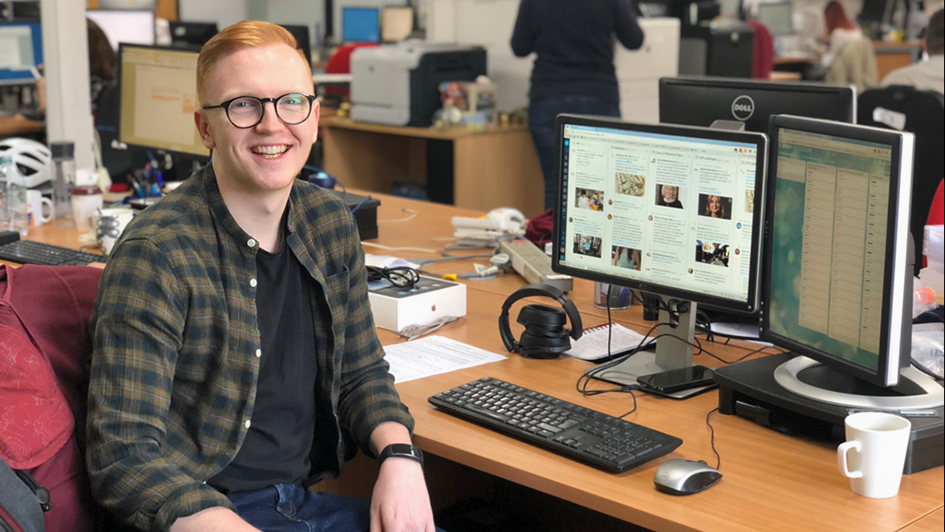
Solomon Brown - Digital Communications Intern
Fresh from graduating with a degree in Human Biosciences last summer I was ready to take my first step into a career in science. I'd previously spent 11 months in a laboratory and decided that it wasn’t the right path for me, so I was on the lookout for another way to stay at the cutting edge of research without donning a lab coat.
This led me to apply for the role of Digital Communications Intern here at The Institute of Cancer Research, London. It promised to combine a number of my interests – including cancer biology and writing for the web – while also offering the opportunity to see how the website of a leading research organisation is managed.
During my interview I was told I’d mainly be helping create and update content on the ICR website, as well as helping to manage the social media channels that are an increasingly important platform by which people first learn about the ICR.
Since then I’ve been involved in a wide variety of projects working closely with different people in the Communications Directorate, as well as with scientists from across the institution. I feel like I’ve learned a great deal and now that I’m leaving I have the chance to reflect on the opportunities, achievements, and challenges that I’ve encountered during my internship.
We are now accepting applications for the next Digital Communications Internship! The deadline to apply is October 6, 2019.
Find out more
Working at the cutting-edge
My first responsibilities were to assist with the editing of the ICR’s rich output of news items, blog posts and videos. The fantastic research done by our scientists needs to be communicated to the world – that’s a fundamental responsibility for any research organisation.
As a part of my role, I would help to check the final copy of articles, upload them into the website’s content management system, add images and headings where necessary, and help craft accompanying posts for social media.
Many of the ICR’s amazing news stories that were published over the past six months were prepared and published in this way by me. Stories like the lung cancer drug that’s showing promise as new targeted therapy for breast cancer or the scientists that were able to zoom in and watch DNA being read.
It was by far and away the most satisfying part of my internship. I was constantly surrounded by new and exciting cancer developments, all without a lab coat in sight!
Chances to be creative
The process of taking something complex and turning it into something engaging presented a few unexpected opportunities for me to inject some creativity into my work.
For example, around one in four of our website visitors arrive at a news story or blog post from social media. Creating an engaging Tweet or Facebook post that still retained its scientific accuracy was a fun challenge (pro-tip: add a good picture that quickly gets your message across).
Also, research news stories often lend themselves to being represented as a short, snappy, and often colourful ‘infographic’. These images are a great way to quickly get across some key points and encourage our readers to find out more.
Another major part of my job was designing bespoke web pages for our staff and scientists. This involved collaboration between myself and the individuals concerned, along with creativity in deciding how exactly those pages should look in order to best put their messages across.
I found it incredibly rewarding to collaborate for weeks on a project, publish the resulting pages, and then receive feedback telling me that the pages looked great.
Crunching the numbers
I was also able to see for myself the positive effects of my hard work when they were reflected in the numbers of people visiting the website. We use Google Analytics – a tool for tracking website performance – and I learned how to harness its power in order to see a wide range of useful statistics.
It was with this tool that I could see how well my new content was performing or whether an update to existing content was achieving the improvements that I’d hoped for.
A good example of this was with news stories; I could see in near real-time how much traffic was coming in to the story, where it was coming from, and how much was coming from my social media posts that I had created.
Meeting challenges
My team were good at gradually increasing the number of projects I was involved with to suit my abilities, and protecting me from the hundreds of emails that passed through the team inbox each week. However, there were some events that impacted on my workload which couldn’t be avoided.
Like the time that five news stories and blogs all needed to be published in a single day, or the week when both my colleagues were unfortunately away at the same time and I held he fort on my own, or the major website upgrade that had to be overseen while still preparing new content for the website.
These events were definitely challenging and required me to step up to the mark somewhat. But I would also credit them for teaching me some very valuable organisational skills that I can see myself using in my future career.
Exceeded my expectations
Overall, the range of projects I’ve worked on and the diversity of people I’ve worked with has far exceeded my initial expectations. I’ve picked up a wide range of new skills and learned some important lessons about how an effective communications department operates.
I’m really pleased to have been the first to fill this role for the ICR and would highly recommend it to anybody thinking about a career in science communication.
Applications for the next Digital Communications Internship are open until Sunday 13 May. Apply here!
comments powered by